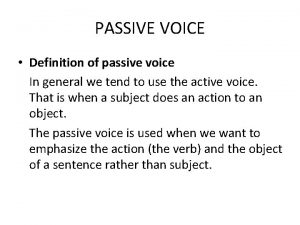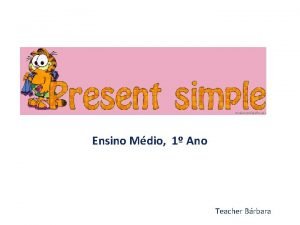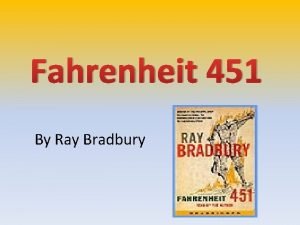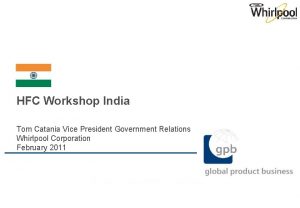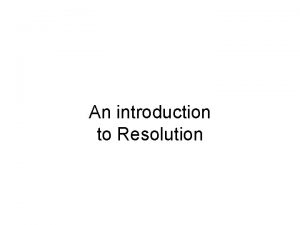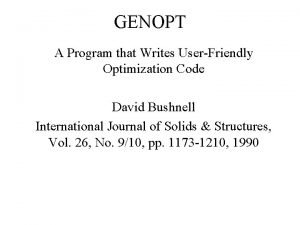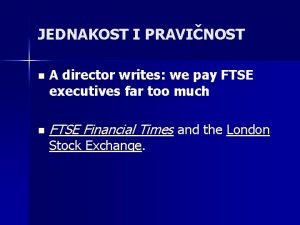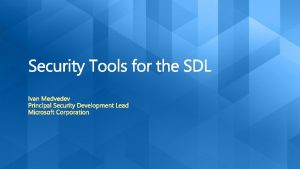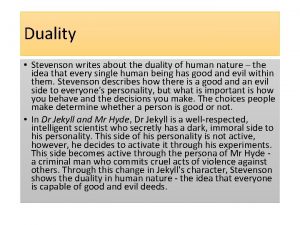RESOLUTION WORKSHOP WHO WRITES A RESOLUTION v Any
























- Slides: 24

RESOLUTION WORKSHOP

WHO WRITES A RESOLUTION? v Any delegate in the committee (although in rare instances an observer state is not allowed to directly write a resolution). v The author of a resolution is called a sponsor (most have multiple sponsors because it takes a group of countries to share good ideas and to come to a consensus)

WHAT IS A RESOLUTION? v A resolution is a document that contains all the issues that the committee wants to solve and the proposed solutions to that issue. v Technically, the resolution should be called a draft resolution before it is voted upon and then called a resolution after it is successfully passed during voting bloc

WHEN AND WHERE IS A RESOLUTION WRITTEN? v Most conferences require students to write resolutions during the conference. Specifically, resolutions are usually written during unmoderated caucus (sometimes called informal caucus) where delegates are free to roam around the committee to collaborate on ideas with each other, and sometimes students work outside in hallways or computer labs as well.

v Resolution-writing becomes more focused during the latter sessions of committee when different country policies are clear and different ideas have been mentioned already. These conferences will not allow any prewritten resolutions. v A few conferences have “docket-style” debate. This is when students are required to submit resolutions to the conference in advance and the chairs pick the best ones and put them into a docket. The delegates focus only on the resolutions in the docket when they get to the conference and work on amending them.

WHY DO WE WRITE RESOLUTIONS? v The ultimate purpose of a committee session is to pass a resolution. All the speeches, debate, negotiation, and teamwork is supposed to lead up to a resolution which contains all the proposed solutions to the issue. The resolution(s) that the majority of the committee agrees upon will be passed during voting bloc and the sponsors will be informally commended for building consensus on good ideas.

A SUCCESSFUL RESOLUTION v appeal to the majority of the parties (states) involved and doesn’t contradict. v Gives solutions to both sides, which are just, and doesn’t punish one side completely, or favour the other side completely v Doesn’t only touch on the factors involved in the issue— they aim to resolve many or most of the factors involved and offer incentives to the various problems, which contribute to the issue.

HOW TO WRITE A RESOLUTION? v. It has 3 main parts: • • Heading Pre-ambularoty Clauses Operative Clauses Amendments

1. HEADING v The heading contains four pieces of information: the committee name, the sponsors, the signatories, and the topic (not necessarily in that order depending on each individual conference’s rules). v The committee name and topic should be self-explanatory. v The sponsors are the authors of the resolution. v The signatories are other delegates in the committee who do not necessarily agree with the resolution but would like to see it debated.


2. PRE-AMBULATORY CLAUSES v The pre-ambulatory clauses state all the issues that the committee wants to resolve on this issue. It may state reasons why the committee is working on this issue and highlight previous international actions on the issue. Pre-ambulatory clauses can include: v Past UN resolutions, treaties, or conventions related to the topic v Past regional, non-governmental, or national efforts in resolving this topic v References to the UN Charter or other international frameworks and laws v Statements made by the Secretary-General or a relevant UN body or agency v General background information or facts about the topic, its significance, and its impact.


HOW TO WRITE PREAMBULATORY CLAUSES v First, take a statement that you want to write about (perhaps an issue you want to solve or a specific fact from one of the five bullet points from the previous slide). v You then take that statement, combine it with an underlined pre-ambulatory phrase, and end it with a comma.


EXAMPLE v For example, my country wants to address the issue of how HIV/AIDS has spread rapidly in sub-Saharan Africa. I pick a pre-ambulatory phrase from above — I’ll use “Alarmed by” — and then I combine it to say: v Alarmed by the 17% increase in HIV/AIDS contraction among sub-Saharan African countries in the past five years, v Strategy Tip: In general, you want fewer pre-ambulatory clauses than operative clauses. More operative clauses convey that you have more solutions than you have problems.

3. OPERATIVE CLAUSES v Operative clauses state the solutions that the sponsors of the resolution proposes to resolve the issues. v The operative clauses should address the issues specifically mentioned in the pre-ambulatory clauses above it.


HOW TO WRITE AN OPERATIVE CLAUSE v First, take a solution that you want to include in the draft resolution. v Take that solution, combine it with an underlined operative phrase, and end it with a semicolon (the last operative clause ends with a period). v Operative clauses are also numbered. This differentiates them from pre-ambulatory clauses, helps show logical progression in the resolution, and makes the operative clauses easy to refer to in speeches and comments.


EXAMPLE v For example, my first solution is to distribute low-cost medicines for HIV/AIDS to sub-Saharan African countries. I pick an operative phrase from above — I’ll use “Calls upon” — and then I combine it and number it to say: v 1. Calls upon the developed countries and major pharmaceutical countries to provide low-cost, generic medicines for HIV/AIDS to sub-Saharan African countries; v Strategy Tip: Usually more details in an operative clause will make it stronger or at least make the idea more clear to other delegates. A simple way to strengthen each operative clause is to answer the “who, what, when, where, why, and how” of each resolution. These details can actually be broken down into sub-operative clauses underneath the main operative clause.

AMENDMENTS v Approved draft resolutions are modified through amendments. v An amendment is a written statement that adds, deletes or changes an operative clause in a draft resolution.

A FRIENDLY AMENDMENT v A friendly amendment is a change to the draft resolution that all sponsors agree with. v After the amendment is signed by all of the draft resolution’s sponsors and approved by the committee chair, it will be automatically incorporated into the resolution.

UNFRIENDLY AMENDMENT v An unfriendly amendment is a change that some or all of the draft resolution’s sponsors do not support and must be voted upon by the committee. v This also refers to delegates who did not write this resolution at all but see potential in it as long as several changes are made to it. v The sponsors of the amendment will need to obtain a required number of signatories in order to introduce it. Prior to voting on the draft resolution, the committee votes on all unfriendly amendments.

IF YOU NEED MORE INFO v Go to the THIMUN guide v Visit the BCNMUN website: mun. a-s-b. com • For example resolutions or issues to practice
 Pertanyaan terbuka
Pertanyaan terbuka There isn't any chicken
There isn't any chicken Any to any connectivity
Any to any connectivity High resolution low resolution
High resolution low resolution Fahrenheit 451 quick writes
Fahrenheit 451 quick writes The girl drove the blue car passive voice
The girl drove the blue car passive voice Ariano suassuna writes horror stories in negative form
Ariano suassuna writes horror stories in negative form Every week his mother goes to
Every week his mother goes to The empire writes back themes
The empire writes back themes Whatever goes upon two legs is an enemy meaning
Whatever goes upon two legs is an enemy meaning Sits on desk and displays what is running on the computer
Sits on desk and displays what is running on the computer Excuse me, _____in that house?
Excuse me, _____in that house? Shakespeare blank verse
Shakespeare blank verse Types of dystopian control
Types of dystopian control Excuse me, _____in that house? *
Excuse me, _____in that house? * The house on mango street chapter 1 questions and answers
The house on mango street chapter 1 questions and answers Palm beach writes
Palm beach writes Fahrenheit 451 quick writes
Fahrenheit 451 quick writes Persuade the reader
Persuade the reader Farenheight 451 movie
Farenheight 451 movie Cecil writes the equation for the reaction of hydrogen
Cecil writes the equation for the reaction of hydrogen Brief writes
Brief writes Who writes the individual's pcisp
Who writes the individual's pcisp My sister is more outgoing than my brother because
My sister is more outgoing than my brother because Tom catania
Tom catania





